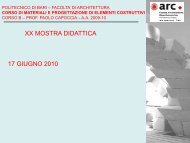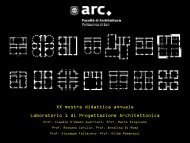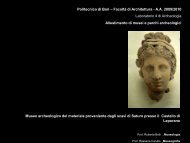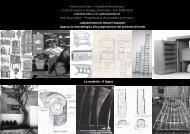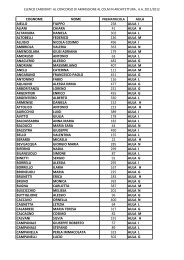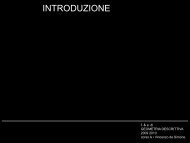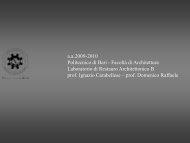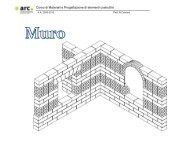44. I regolamenti <strong>di</strong>dattici80protobizantino, o <strong>il</strong> ‘protorinascimento’toscano, per poi concludere con lo sv<strong>il</strong>uppodel nuovo linguaggio rinascimentale inToscana ed in Italia.Lezioni1. La bas<strong>il</strong>ica da spazio pubblico a spaziosacro. La pianta centrale: dall’heroon almartyrium, dal nymphaeum al baptisterium.2. L’architettura protobizantina aCostantinopoli e Ravenna, ultima capitale.3. Il monachesimo in Oriente e Occidente.L’impero <strong>di</strong> Carlo Magno.4. Sv<strong>il</strong>uppi dell’architettura carolingia eottoniana: <strong>il</strong> protoromanico.5. Il Romanico in Francia: le chiese <strong>di</strong>pellegrinaggio, la Provenza e l’Aquitania.6. Il Romanico in Francia: la Borgogna e laNorman<strong>di</strong>a.7. Il Romanico in area lombarda, toscana eromano-campana.8. Origini dell’architettura gotica in Francia,sv<strong>il</strong>uppi della volta a crociera da esapartita aquadripartita.9. L’architettura in Italia meri<strong>di</strong>onale dai renormanni a Federico II.10. L’architettura gotica dai Cistercensi aglior<strong>di</strong>ni men<strong>di</strong>canti. Arnolfo <strong>di</strong> Cambio,cattedrali e palazzi pubblici in Italia centrale.11. F<strong>il</strong>ippo Brunelleschi: l’esperienza deicostruttori <strong>di</strong> cattedrali e la rinascita deglior<strong>di</strong>ni.12. Leon Battista Alberti e la riscoperta <strong>di</strong>VitruvioStoria dell’architettura modernaL’architettura del Classicismo (1400-1800): siindagherà lo sv<strong>il</strong>uppo del linguaggio ed <strong>il</strong>suo continuo evolversi e mutare attraversole opere dei principali architetti delRinascimento, soprattutto in Italia. Si faràriferimento alla sua affermazione <strong>di</strong>“tendenza” in Europa, alla sua “mutazione”nel Barocco, fino alla crisi della stessa idea<strong>di</strong> classicismo coincidente con l’affermarsidel neoclassicismo ed <strong>il</strong> nascere dellostoricismo.A partire dalla ripresa dell’antico nel 400con Brunelleschi e Alberti fino alla “grandemaniera” <strong>di</strong> Bramente e Raffaello nelleRoma del Cinquecento, all’esperienze <strong>di</strong>Michelangelo, Vignola e Maderno. Si tratteràpoi <strong>il</strong> barocco come sv<strong>il</strong>uppo delRinascimento, a Roma e fuori Roma (Bernini,Borromini, Pietro da Cortona, Guarini,Longhena) fino alla sua cristallizzazioneclassicista nel Settecento (Vanvitelli, Salvi,Juvarra ) ed in<strong>di</strong>viduare infine la suatrasformazione nel nuovo linguaggioneoclassico (da Piranesi a Stern) che aprel’Ottocento.Le esercitazioni saranno de<strong>di</strong>cate all’analisi<strong>di</strong> un’opera <strong>di</strong> architettura religiosa in Italia.Si richiederà ad ogni studente <strong>di</strong> pre<strong>di</strong>sporreuna scheda <strong>di</strong> un e<strong>di</strong>ficio compreso nell’arcocronologico trattato (1200-1800);dell’e<strong>di</strong>ficio si opererà una letturabibliografica, archivistica e grafica. La sceltadegli e<strong>di</strong>fici sarà concordata con la docenza.Lezioni1. Bramante e la grande maniera2. Dopo Bramante: Roma nel primo 500 e la<strong>di</strong>ffusione del nuovo linguaggio3. Il Rinascimento nel Veneto: (Sammicheli,Sansovino, Palla<strong>di</strong>o)4. Michelangelo e l’architettura romana delsecondo 5005. Gian Lorenzo Bernini e l’unità delle artivisive6. Francesco Borromini architettosperimentatore7. Architettura del 600 in Italia (Pietro daCortona, Carlo Rainal<strong>di</strong>, BaldassarreLonghena)8. Il barocco a Torino: da Guarini a Juvarra9. Architettura Barocca a Napoli e in Puglia10. Architettura del 700 a Roma ed in Italia11. Piranesi e la nascita del neoclassicismo:da Roma all’Europa12. L’Architettura della Ragione in EuropaArticulation of educational activitiesThe course is <strong>di</strong>vided into lessons andexercises. Even wh<strong>il</strong>e making the necessaryreferences to the history of society, culture,ideas and art in general, the course w<strong>il</strong>l dealabove all with the delineation of a history ofthe forms of architecture in their variousmeanings, with the evolution of theirconception and construction, of how some ofthem remain or return wh<strong>il</strong>e others mutateand evolve.History of me<strong>di</strong>eval architectureThe course concerns the architecturaldevelopment in Me<strong>di</strong>eval Europe, consideringthe main monuments of the Me<strong>di</strong>terraneanand Continental Europe unt<strong>il</strong> 1492. Thearchitectures w<strong>il</strong>l be considered in theirhistorical background, accor<strong>di</strong>ng to theevolution of the bu<strong>il</strong><strong>di</strong>ng techniques. Thecontrast between the tra<strong>di</strong>tionalMe<strong>di</strong>terranean masonry and the Nor<strong>di</strong>cskeletal frames and shell surfaces w<strong>il</strong>l remainrecognizable unt<strong>il</strong> the Modern movement inthe 20th century. The History of Me<strong>di</strong>evalArchitecture w<strong>il</strong>l put emphasis on the Classicalheritage, considering the <strong>di</strong>fferentRenaissances, i.e. the Perennial Hellenism ofearly Byzantium, or the Carolingian revival ofAntiquity, unt<strong>il</strong> the modern Renaissance inTuscany.Topics1. The religious transformation of theBas<strong>il</strong>ica and the Central planned Bu<strong>il</strong><strong>di</strong>ngs:Heroa, Martyria, Nymphaea, Baptisteria.2. Early Byzantine Architecture atConstantinople and the Ravenna Exarchate.3. Monastic Architecture in Eastern andWestern Church. The Reign of Charlemagne.4. Developments of Carolingian and Ottonianarchitecture: the Proto-Romanesque.5. Romanesque Architecture in France: theChurches of the P<strong>il</strong>grimage Roads, theRegional Schools in Provence and Aquitania.6. Romanesque Architecture in France: theRegional Schools in Burgundy and Normandy.7. Romanesque Architecture in Lombardarea, Tuscany and Rome.8. Origin and developments of the GothicArchitecture in France: from sexpartite tooblong quadripartite vaults.9. Architecture in the Kingdom of Two Sic<strong>il</strong>iesfrom Norman Kings to Frederic II.10. Gothic Architecture from the Cistercians toMen<strong>di</strong>cant Orders. Arnolfo <strong>di</strong> Cambio, theCathedrals and Municipal halls in Central Italy.11. F<strong>il</strong>ippo Brunelleschi: the tra<strong>di</strong>tion of theCathedrals bu<strong>il</strong>der and the Renaissance of theArchitectural Orders.12. Leon Battista Alberti and the re<strong>di</strong>scoveryof Vitruvius’ De Architectura.History of modern architectureThe Architecture of Classicism (1400-1800):the course w<strong>il</strong>l investigate the development ofthis language and its continual evolution and
mutation through the works of the principalarchitects of the Renaissance, above all inItaly. Reference w<strong>il</strong>l be made to its affirmationas a “fashion” in Europe, and its “mutation”during the Baroque period, up unt<strong>il</strong> the crisisof the very idea of Classicism, coinci<strong>di</strong>ng withthe affirmation of neo-classicism and the birthof historicism.Beginning with a look at the historicalreferences in the 15th-century of Brunelleschiand Alberti, up unt<strong>il</strong> the “grande maniera” ofBramante and Raphael in 16th-century Rometo the experiences of Michelangelo, Vignolaand Maderno. The Baroque period w<strong>il</strong>l bedealt with as a development of theRenaissance, both in Rome and outside ofRome (Bernini, Borromini, Pietro da Cortona,Salvi, Juvarra), and through the observation ofits final transformation into the new languageof neo-classicism (from Piranesi to Stern) thatbegan in the 19th-century.The exercises w<strong>il</strong>l be de<strong>di</strong>cated to the analysisof a work of religious architecture in Italy. Eachstudent w<strong>il</strong>l be asked to provide a chart for aspecific bu<strong>il</strong><strong>di</strong>ng, included within the period oftime being dealt with in both courses (1000-1800); the study of the bu<strong>il</strong><strong>di</strong>ng w<strong>il</strong>l include abibliographic, archival and graphic rea<strong>di</strong>ng.The choice of the bu<strong>il</strong><strong>di</strong>ng must be agreedupon with the course professor.Topics1. Bramante and the Grande Maniera2. After Bramante: Roma in the beginning ofXVIth century and the new language’s<strong>di</strong>ffusion3. Renaissance in Veneto: (Sammicheli,Sansovino, Palla<strong>di</strong>o)4. Michelangelo and the architecture inRome (1550-1600)5. Gian Lorenzo Bernini and the unity ofvisual arts6. Francesco Borromini, architect andexperimenter7. Architecture of XVIIth in Italy (Pietro daCortona, Carlo Rainal<strong>di</strong>, BaldassarreLonghena)8. Baroque in Torino:from Guarini to Juvarra9. Baroque Architecture in Southern Italy10. Architecture of XVIIIth in Rome and Italy11. Piranesi and the Rise of the Neoclassicism:from Rome to Europe12. Architecture of Enlightenment in EuropeIscrizione al corsoLe iscrizioni avvengono obbligatoriamentesulla piattaforma entro i primi <strong>di</strong>eci giornidall’inizio dei corsi.Per iscriversi lo studente deve averesostenuto tutte le propedeuticità previste.È ammessa l’iscrizione con riserva perquegli studenti che sosterranno tutte lepropedeuticità previste entro la sessioneinvernale. La mancata verifica <strong>di</strong> questacon<strong>di</strong>zione implica a febbraio l’automaticadecadenza della iscrizione.Modalità d’esameL’esame consiste nella presentazione dellavoro svolto nelle esercitazioni. Inoltre lostudente deve <strong>di</strong>mostrare la conoscenzadel programma svolto sia attraversol’esposizione orale, sia attraverso <strong>il</strong>riconoscimento <strong>di</strong> alcune architetture e lacapacità <strong>di</strong> saper tracciare schemi <strong>di</strong> pianteed alzati delle opere trattate.StaticaStaticsIcar 08-8,5 cfu2° anno / corso annualeIn<strong>di</strong>rizzi ‘generale’ e ‘classico’Area <strong>di</strong>dattica IV:Analisi e progettazione strutturaledell’architetturaCorso APietro D’AmbrosioCorso BUmberto RicciutiFinalità e contenuti <strong>di</strong>sciplinariIl corso si propone principalmente <strong>di</strong>realizzare una solida base propedeutica perl’appren<strong>di</strong>mento delle <strong>di</strong>scipline dell’areastrutturale. Prettamente propedeutici sonoi primi due argomenti, ossia la teoria deivettori applicati e la geometria delle masse.I successivi hanno invece anche un <strong>di</strong>rettointeresse applicativo, in quanto, purtrattando principi generali della statica,sono già orientati alla posizione e allarisoluzione <strong>di</strong> bas<strong>il</strong>ari problemi strutturali.Tutti i temi del corso hanno carattere<strong>di</strong>rettamente applicativo. Tali sono adesempio l’analisi cinematica e statica dellatrave piana o dei sistemi piani <strong>di</strong> travi, rigi<strong>di</strong>od articolati, nonché la definizione e ladeterminazione delle caratteristiche dellasollecitazione, tema quest’ultimo cui ède<strong>di</strong>cato notevole spazio. Particolareinteresse applicativo presenta poi l’ultimotema ossia lo stu<strong>di</strong>o delle travaturereticolari piane, classici e sempre attualitipi strutturali.Aims and contentsThe aim of the course is to provide apreparatory basis for the learning ofstructural subjects.The first two sections are devoted tovectorial theory applied to statics andgeometry of solids. Thereafter, attention isfocused on applications and the generalprinciples of statics are oriented to thesolution of basic structural problems.The whole course has a practicalconnotation: kinematical and staticanalysis of plane beams, plane systems ofrigid or articulated beams; definition anddetermination of internal actions are someof the practical questions that w<strong>il</strong>l bedeveloped. Particular attention is reservedto the study of plane trusses, a classicalbut st<strong>il</strong>l relevant structural type, whichrepresents a very interesting applicationoriente<strong>di</strong>ssue.Lezioni ed esercitazioni del 1° semestre1-Illustrazione e introduzione al corso.Definizione <strong>di</strong> “vettore”. Somma <strong>di</strong> vettori eprodotto <strong>di</strong> un vettore per un numero reale.-Prodotto “interno”, prodotto “esterno” eprodotto “misto” fra vettori. Proprietà delleoperazioni fra i vettori.2-Esercitazioni sulle operazioni con i vettori.Doppio prodotto vettoriale.Lezione-Rappresentazione cartesiana dei vettori.Operazioni con i vettori nella44.2.9 Progetti <strong>di</strong>dattici del I ciclo del CdLm in Architettura81
- Page 1:
0607Politecnico di BariFacoltà di
- Page 4 and 5:
Politecnico di Bari, Facoltà di Ar
- Page 6 and 7:
4. Regolamenti didattici4.1. Il Reg
- Page 8 and 9:
PresentazionePresentazioneLa Facolt
- Page 11 and 12:
Le strutture didattiche e di suppor
- Page 13 and 14:
giorno e dando, quindi, esecutivit
- Page 15 and 16:
• esprimere pareri sui compiti di
- Page 17 and 18:
1.3. La Biblioteca di FacoltàIl pa
- Page 19 and 20:
2. Strutture di ricerca e di suppor
- Page 21 and 22:
BIO 07, Ecologia43 Mariavaleria Min
- Page 23 and 24:
le richieste e le iniziative ad ess
- Page 25:
2.3 Le biblioteche d’area2.3.1 Le
- Page 28 and 29:
33. La didattica e gli studenti263.
- Page 31 and 32: 4. I Regolamenti didattici4.1. Rego
- Page 33 and 34: presente regolamento;• le propede
- Page 35 and 36: discussi ed i voti finali.Per ciasc
- Page 37 and 38: 4.2.4 Definizione delle aree discip
- Page 39 and 40: laurea da attivare in base al numer
- Page 41 and 42: non venga superato l’iscrizione a
- Page 43 and 44: Manifesto del CdLs in Architettura
- Page 45 and 46: Manifesto del CdLm in Architettura
- Page 47 and 48: ciclo provenendo da altri Atenei.È
- Page 49 and 50: Manifesto del CdLs in Architettura
- Page 51 and 52: Manifesto del CdLm in Architettura
- Page 53 and 54: Insegnamenti ssd Crediti Laboratori
- Page 55 and 56: Insegnamenti ssd Crediti Laboratori
- Page 57 and 58: Insegnamenti attivati e docenti per
- Page 59 and 60: Insegnamenti attivati e docenti per
- Page 61 and 62: Finalità e contenuti disciplinariN
- Page 63 and 64: Lezioni- L’architettura etrusca e
- Page 65 and 66: ibliografiche, volte ad acquisire g
- Page 67 and 68: Discipline tecnologiche per l’Arc
- Page 69 and 70: Istituzioni di geometria I + Istitu
- Page 71 and 72: architettonicoTopicsLife drawing, u
- Page 73 and 74: • Representation of the shadows
- Page 75 and 76: frequenza del corso che consentel
- Page 77 and 78: capacità di valutazione storico-cr
- Page 79 and 80: scale edilizie e tra diversi tipi;
- Page 81: planning of Roman suburban andcount
- Page 85 and 86: -Equazioni indefinite di equilibrio
- Page 87 and 88: coerenza tra qualità funzionale, c
- Page 89 and 90: transformations (psychrometry).In t
- Page 91 and 92: madrepatria.4. La colonizzazione e
- Page 93 and 94: EtruscologiaEtruscologyL-ANT/07 - 4
- Page 95 and 96: Archeologia e Storia dell’Arte Ro
- Page 97 and 98: The student will develope the archi
- Page 99 and 100: tanto il rapporto tra elementi, str
- Page 101 and 102: sociale dell’abitare (Loos, Tesse
- Page 103 and 104: experimental research into the beha
- Page 105 and 106: Articolazione dell’attività dida
- Page 107 and 108: Aims and contentsThe Urban Sociolog
- Page 109 and 110: nell’ambito dell’annuale “mos
- Page 111 and 112: di laurea. Sarà quindi necessario
- Page 113 and 114: - Ancient modern Rome: the continui
- Page 115 and 116: During the lessons, theoretical and
- Page 117 and 118: Le esercitazioni costituiscono lo s
- Page 119 and 120: typological and technical innovatio
- Page 121 and 122: • la fenomeni di propagazione del
- Page 123 and 124: Aims and contentsThe urban economy,
- Page 125 and 126: value of a civil apartment with the
- Page 127 and 128: l’elaborazione della tesi di rice
- Page 129 and 130: 4.3.8 Esame di laureaPer essere amm
- Page 131 and 132: semestrale• Laboratori di sintesi
- Page 133 and 134:
4.3.14 Manifesto del CdL in Disegno
- Page 135 and 136:
4.3.16 Organizzazione delle attivit
- Page 137 and 138:
4.3.17 Insegnamenti e docenti per a
- Page 139 and 140:
Laboratorio di Disegno industriale
- Page 141 and 142:
• metodo dell’assonometria;•
- Page 143 and 144:
fine dell’Ottocento; le avanguard
- Page 145 and 146:
Iscrizione al corsoLe iscrizioni av
- Page 147 and 148:
Laboratorio di Arredamento 2/IInter
- Page 149 and 150:
Disegno 2/IIDrawing 2/IIIcar 17-5 c
- Page 151 and 152:
communication, as follows:• typog
- Page 153 and 154:
4.3.22 Progetti didattici3° anno
- Page 155 and 156:
sintetiche, segnaletica interna ed
- Page 157:
esercitazioni pratiche, attività d
- Page 160 and 161:
55. Relazioni internazionali1585.1
- Page 163 and 164:
6. Post Lauream6.1. Dottorato di Ri
- Page 165 and 166:
Attività di ricercaLo svolgimento
- Page 167 and 168:
particolari e specifiche competenze
- Page 169 and 170:
iscrizione all’esame di ammission
- Page 171 and 172:
scientifico-disciplinare in cui è
- Page 173:
• alla sicurezza statica (corrett
- Page 176 and 177:
a.1 Planimetria del campus epiante
- Page 178 and 179:
Status accademico dei docentiDocent
- Page 180 and 181:
aAppendici178A.3 Indice dei nomiAAc
- Page 182 and 183:
aAppendicia.5 Calendario annuale de




